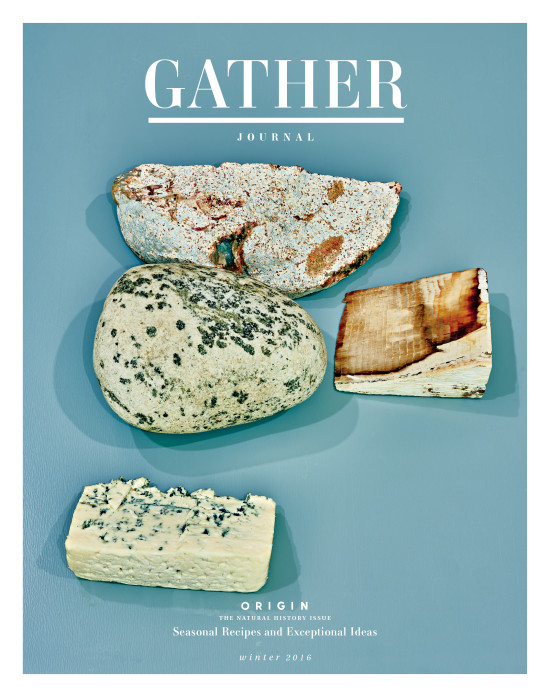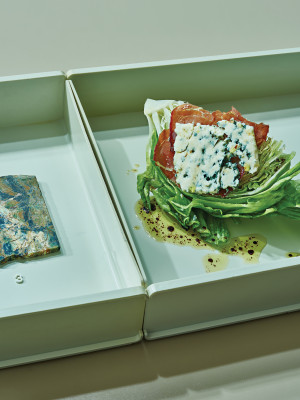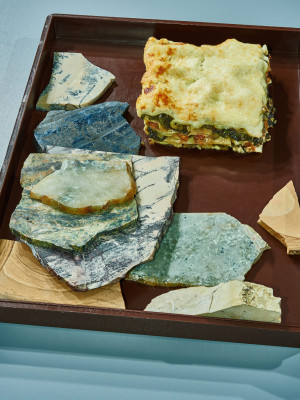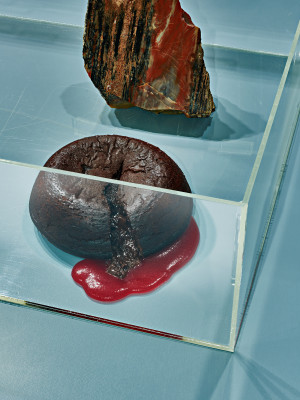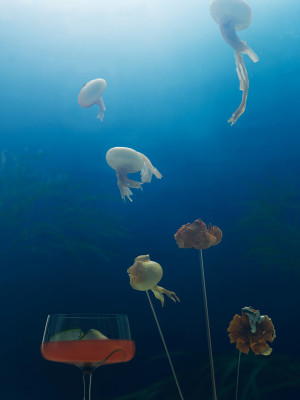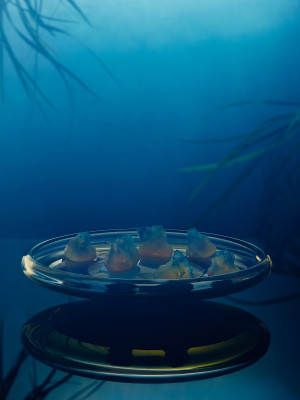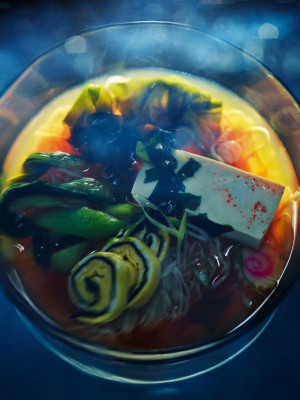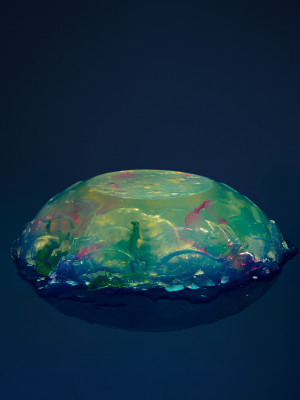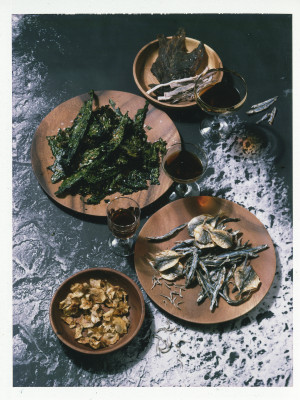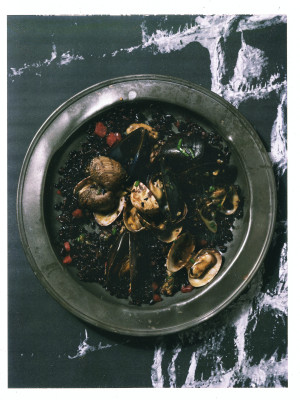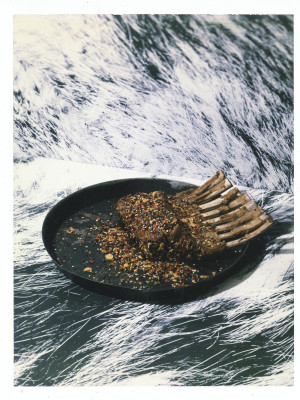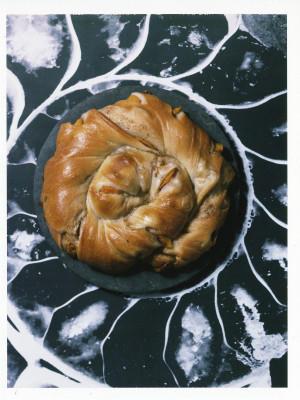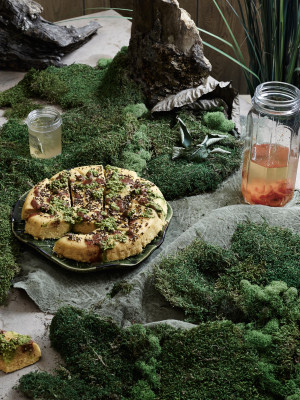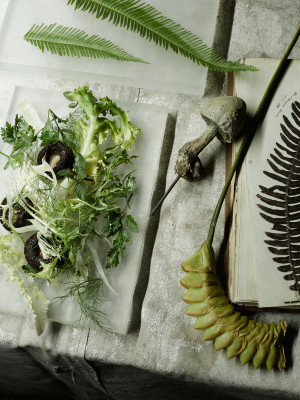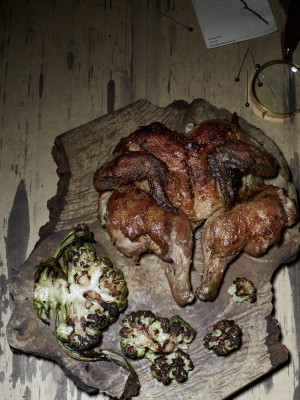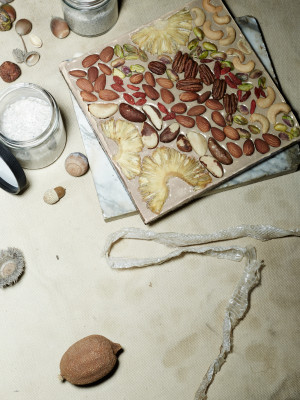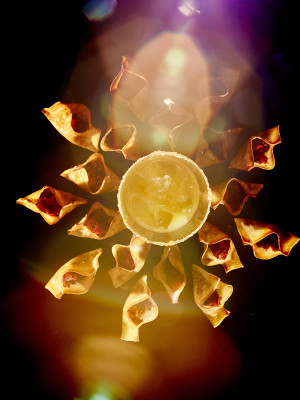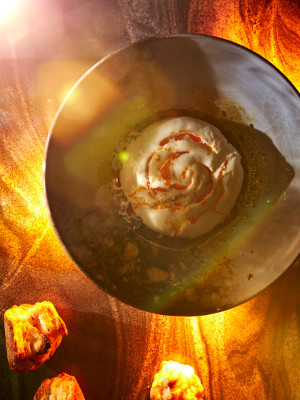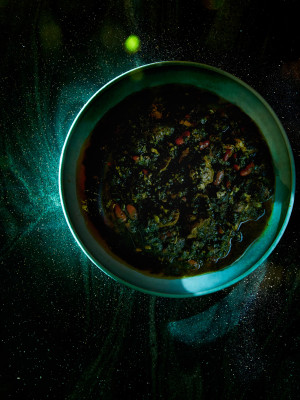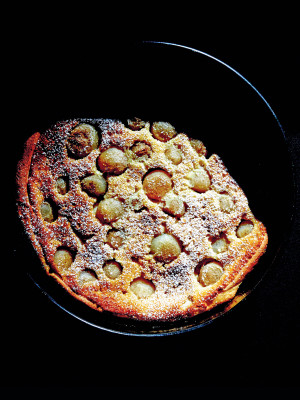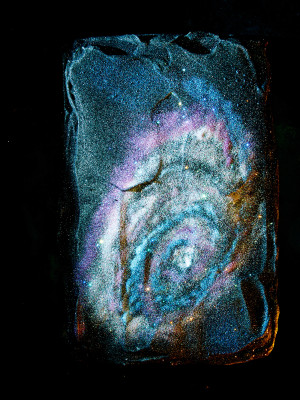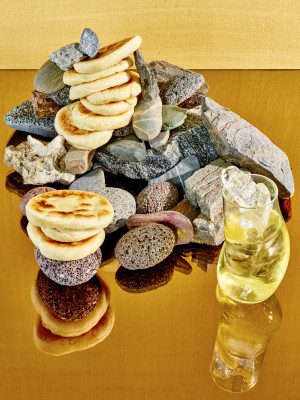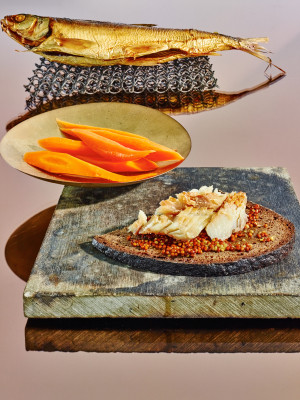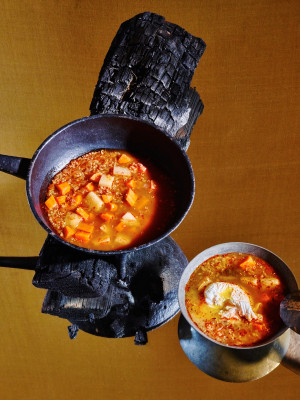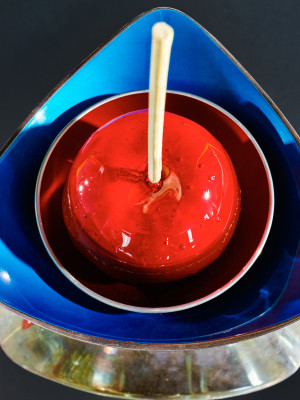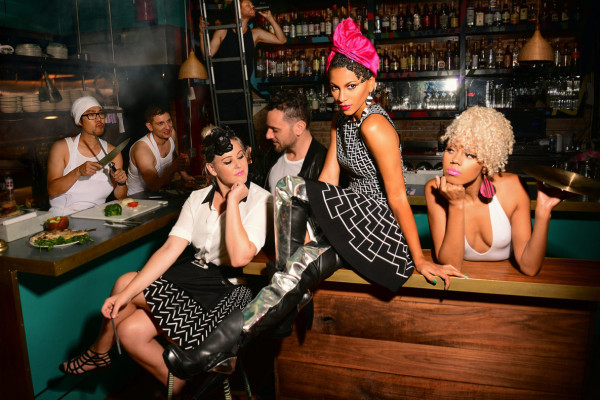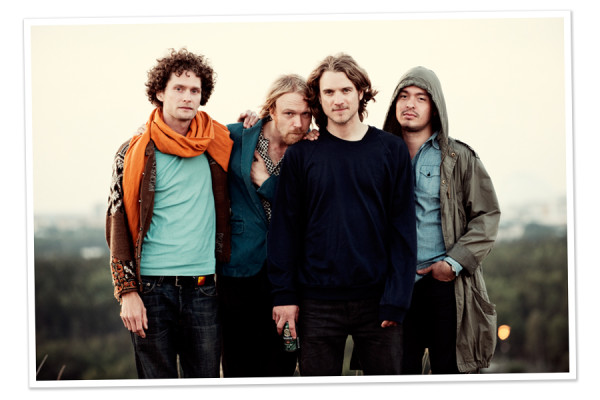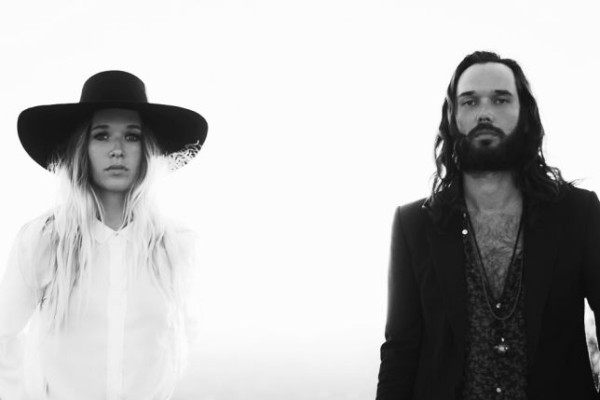The eighth “Origin” edition of Gather Journal explores the many aspects of natural history. Origin indicates the beginning of something, and nature is itself the greatest source, giving rise to everything around us. Including, what we find on our plate.. Chapters are arranged by a few of the areas of study that natural history encompasses—geology, space, fossils, the ocean, biodiversity, and the ages—each one spawning its own menu. There’s even a feature inspired by the museum’s famous hall of minerals, though our glimmering crystal blocks are cast from a very different—and sweeter—material.
Cover: Photograph by Keirnan Monaghan, Food Styling by Maggie Ruggiero, Prop Styling by Theo Vamvounakis
In 2014 scientists in remote Western Australia found a tiny rock with a big story: a microscopic shard of zircon that, at 4.4 billion years old, dates back almost to our planet’s beginnings. Crystals on its surface (a sign of water exposure) revealed Earth may not have been so inhospitable (sizzling rocks, crashing asteroids) back then as we had initially suspected. Coaxing out the stories that rocks have to tell is just one facet of geology, the study of the earth’s physical history. We pay homage to this, most grounded, science with an onion, mushroom, and buckwheat bread hewn to resemble shale and sandstone; a craggy iceberg slab with mottled blue cheese; a stratified lasagna that nods to the earth’s layers; and an explosive molten chocolate volcano.
“The sea, once it casts its spell, holds one in its net of wonder forever.” From Jacques Cousteau, there could be no truer words. Plumbing the ocean’s depths for new marvels was his mission. So too was protection; Cousteau alerted us to the impact of pollution, overfishing, and the pillaging of coral reefs, and his predictions were prescient. The ocean is a remarkable contra- diction, mighty and fragile. And it must be treated with rever- ence—because we’re all in the same boat. Our menu is a tribute to the astonishing world that lurks beneath the ocean’s surface— cipollini onions, anemone-like in appearance; floaty crystalline dumplings with shrimp; a wintry ramen stacked with seaweed; and an aquarium rendered in coconut and lychee jelly.
She sells seashells by the seashore. A well-known tongue-twister inspired by someone far lesser-known. Because she was poor and, more signi cantly, a woman, Mary Anning, a 19th-century fossil hunter on England’s Dorset coast, didn’t get her due in her lifetime. But her discoveries (like a near-intact Plesiosaur in 1823) were hugely signi cant. Fossils are the earth’s own testimony; preserved evidence that etch a timeline of how our planet evolved. Our fossil menu (photographed using what will be an industry fossil, a 4 x 5 camera)—a seemingly sun-baked smörgâsbord; a mollusk-embed- ded platter of inky forbidden rice; a Jurassic-sized rack of Dong Bei lamb; and a swirling loaf of persimmon-patched ammonite bread— will leave its own traces.
The Manu and Yasuni National Parks in Peru and Ecuador are considered the world’s most formidable bastions of biodiversity. But in New York, where the greatest diversity of species is among humans, the Museum of Natural History takes on new signifi- cance; their vast Hall of Biodiversity, with its encyclopedic array of fungi and ferns, flora and fauna, a transporting experience. Our small-scale version (we gave it a distinct ’70s-era Eastern Europe- an vibe) is the ideal backdrop for an immersive meal that plucks from the vast realm of the plant kingdom—dhokla bites, mossy in appearance; a raveled pile of bitter greens and mushrooms; a splayed chicken with green cauliflower slabs; and a chia pudding served with a nut bar, panoramic in scope.
About 100 years ago, Einstein’s theory of relativity altered how we think about space and time by proving they were connected in a single continuum. e theory made sense of how planets move, unveiled black holes, and made us look skywards with a new sense of wonder. Wonder is what many felt when they glimpsed September’s rare (another won’t occur until 2033), super blood moon, or heard, just 12 hours later, the NASA news that water, and therefore, the potential for life, had been discovered on the red planet. Space will always transfix, mesmerizing us with its existential possibilities, and so too does our menu inspired by the great beyond: a sunburst of spicy purses; a vadouvan-doused burrata reball; a dusky “black hole” stew; a brown butter and pear lunar clafoutis; and a gingerbread tres leches “milky way” cake.
From Fred Flintstone to a fur bikini-clad Raquel Welch in
One Million Years B.C. to the club-wielding cro-magnons in 2001’s famous Dawn of Man sequence, pop culture’s depictions of the prehistoric are many. But recently we have begun to look back—way back—not for entertainment value, but at the hunter- gatherer diets that helped our ancestors avoid the pitfalls of disease. Our menu inspired by the Ages is primitive in spirit, not ingredient lists. Dimpled jalapeño and cheese pockets look like they were ground on a rock hearthside; burnished bodkins of smoked whitefish resemble crude weaponry; a Peruvian quinoa stew is a bowl of ancient fortification; and a shiny veneered apple serves as a vision of the future.
Contributors
Noemi Bonazzi
Raised in Milan, Bonazzi came to New York in her twenties as an art dealer before becoming a movie set decorator and then a prop stylist. Onetime style editor for House & Garden, she has collaborated with photogra- pher Francis Halard on a book for the Clarence House textile company. An avowed lover of all things Neapolitan, she lives in Brooklyn with her husband and children.
Food or drink you would smuggle into space: Corn, even though I know it will give me scurvy.
Roger Boulay
The Massachusetts-born artist earned an MFA in photography from the University of New Mexico and an MA in Dutch Art History at the Universiteit van Amsterdam. Now based in the Midwest, where he lives with his amazing partner and two dogs, Boulay has two exhibitions of his work coming up at the University of Rochester and Chicago’s Gallery 19. See his work at rogerboulay.com.
Food or drink you would smuggle into space: My mom’s rhubarb pie, the perfect celebratory successful-mission meal or a fabulous last meal.
Chris Clayton
The St. Paul-based writer and editor’s work has appeared in The Believer, Eater, Outside, and CNN Travel, among others. See his work at chrisclayton.contently.com.
Food or drink you would smuggle into space: A bag of Ellsworth cheese curds.
Nicholas Cope
Photographer Cope moved to L.A. in 2004 to attend the Art Center College of Design. Now New York-based, his lengthy client list includes V, Nike, Dior, Barneys and WSJ Magazine. Powerhouse released his first book, Whitewashed, in 2013. See his work at nicholascope.com.
Food or drink you would smuggle into space: If I were to somehow be cured of my phobia of going to space, I suppose I would do what Homer Simpson did and smuggle some chips aboard. They, of course, would clog the instruments.
Grant Cornett
Photographer Cornett resides in the Catskills, with his beautiful wife Janine, lovely youngest daughter Georgia, and two standard poodles (Jules and Sonny Bruno de la Passion). He’d like to give a special thanks to his amazing oldest daughter Quinn for her help with this story. He is currently shooting this and that for the people. Glimpse his life’s goings-on at thelivest1.com.
Food or drink you would smuggle into space: Pizza.
Kim Ficaro
Ficaro is a New York-based prop/interior stylist. Former style editor of the original Domino, she has been spreading her magic for over a decade. Her clients include Bon Appétit, West Elm, In Style, Anthropologie and Bare Journal. In 2014, she collaborated on a capsule collection for Canvas Home and is the co-author and creator of The Inspired Home by Rizzoli.
Food or drink you would smuggle into space: Mezcal and avocados.
Laurie Frankel
The San Francisco-based award-winning still life, lifestyle, food, and interiors photographer has stomped through swamps, bribed giraffes, charmed distressed babies, and hung precariously from ceilings, all in the name of getting the perfect shot. Frankel credits her experience as a creative director for helping to shape her graphic sensibility and collaborative approach to photography. See her work at lauriefrankel.com.
Food or drink you would smuggle into space: Kale smoothie.
Carol Hayes
Brooklyn-based graphic designer and artist Hayes has worked for West Elm, New York magazine, Little Brown & Company, and Open. She has received design awards from the AIGA, Communication Arts, the Society of Publication Designers, and the Type Directors Club, Her artwork was recently included in Brooklyn pop-up group show Change of Address. See her work at carolhayes.info.
Food or drink you would smuggle into space: Well, you’d have to have coffee. Good, strong, hot coffee— outer space seems so cold!
Linda Heiss
Born and raised in Connecticut, Heiss began her career as a fashion stylist before switching to props. Her clients include Calvin Klein, La Mer, NARS, Dior, T Magazine and The Wall Street Journal. She loves walking in the city and hiking in the Adirondacks. See her work at wschupfer.com.
Food or drink you would smuggle into space: Blueberries picked by me.
Gentl and Hyers
Partners in photography and life, Andrea Gentl and Martin Hyers met while students at Parsons. Focused on food, travel, interiors, and portraits, their clients include Condé Nast Traveler, Bergdorf Goodman, and Grey Goose. The pair recently taught a visual storytelling workshop on Lummi Island in the Paci c Northwest. Their latest cookbook, Hartwood, was just released and they are currently working on a book with Danish chef Mads Refslund. See their work at gentlandhyers.com.
Food or drink you would smuggle into space: Andrea’s tomato sauce and a block of Romano cheese. It’s the rst thing we crave when we travel and is the rst thing we eat when we come home.
Stephen Kent Johnson
New York-based photographer Johnson has shot for Rizzoli, WSJ Magazine, and Martha Stewart Living. See his work at stephenkentjohnson.com.
Food or drink you would smuggle into space: Some Mrs. Richardson’s hot fudge for all that space ice cream.
April Long
Born on a farm in Kansas and raised in Missouri and Florida, Long spent years in London before eventually moving to New York. Currently the executive beauty editor at Elle, where her fragrance features regularly rack up industry accolades, she has also held staff positions at NME, Nylon, and Pop-Up Video. Long lives in Brooklyn with the two loves of her life: husband Will and long-haired chihuahua Lila.
Food or drink you would smuggle into space: A bottle of wine and milk so I have it for my coffee...which would already be there obviously.
Keirnan Monaghan
Monaghan is a native of New York City. He currently lives in Brooklyn with his wife Theo, and two Cornish Rex cats, Joan and Lois. The focus of his work are portraits, still-lifes, and landscapes. See his work at keirnanmonaghan.com.
Richard Joseph Morgan
Before Morgan was an accomplished New York-based writer, he was a missionary in China, hitchhiker in Costa Rica, and a ranch hand in Colorado. His work has appeared in The New Yorker, The New York Times, Playboy, Scienti c American, Slate, The Economist, and Topic (RIP). He is also the author of the 2015 memoir Born in Bedlam.
Food or drink you would smuggle into space: I’d say Communion wafer and wine, but Buzz Aldrin already did that on the moon—poured into a chalice at one-sixth normal gravity. So I’ll go with a pot brownie, in the ISS cupola. People are always saying it’s best to try those out in nature.
Nathan Nedorostek
1. Wabi-Sabi. 2. Sade. 3. Chaka Khan. See his work at nathannedorostek.com.
Food or drink you would smuggle into space: A Nutcracker drink.
Marcus Nilsson
Born in Malmö, Sweden, Nilsson moved to New York to work as a chef, then decided to pursue a degree in photography. Since making food his subject, his client list has grown to include Bon Appétit, Departures, New York, Condé Nast Traveler, Swallow, and The New York Times Magazine. When he’s not shooting, the avid wine collector enjoys throwing dinner parties in his Bushwick digs. He is currently at work on two personal books: Alone and Stoned and A Lesson in Oil Pressure. See his work at marcusnilsson.com.
Food or drink you would smuggle into space: A bottle of Le Temps des Cerises.
Leif Parsons
The Brooklyn-based artist and illustrator’s work has been shown on both coasts and featured in many publications. Recently Parsons has been focused on nding the line between deliberate idea and spontaneous expression, between obervation and imagination. He’s also curious how many times The New York Times will publish naked drawings he’s done of himself (so far, three). Parsons is the writer and illustrator of the children’s book Only Fish Fall From the Sky (available at gatherjournal.com). See his work at leifparsons.com and @leifparsons.
Food or drink you would smuggle into space: Olives. And in a pinch I could make olive oil which is good for everything.
Katy Peetz
Gather’s co-recipe editor made her way to New York from Nebraska to attend culinary school at the International Culinary Center. After graduating Peetz worked in some of the city’s most notable kitchens, on both the pastry and savory sides. She was named one of Zagat’s 30 Under 30 Star Chef’s Rising Star Pastry Chef before stepping into the world of recipe development and food styling. Peetz is currently the associate food editor at Tasting Table. See her work at katypeetz.com.
Food or drink you would smuggle into space: My mom’s banana bread, slightly underdone and gooey in the center.
Rebekah Peppler
Peppler is a Brooklyn-based writer and food stylist. Her clients include a number of cookbooks, as well as online, print, and television outlets among them, The New York Times, Real Simple, Rachael Ray, Epicurious, and Food Network. Her book Honey was released by Short Stack Editions in 2014. See her work at rebekahpeppler.com.
Food or drink you would smuggle into space: A block of six-year-aged Wisconsin cheddar and a bourbon Old Fashioned. You can take the girl out of Wisco but you can’t take the Wisco out of the girl.
Ariana Reines
The Salem, Massachusetts-born poet/ playwright/ artist’s work has been widely published and exhibited. Her rst play, Telephone, commissioned and produced by New York’s acclaimed Foundry Theatre won two Obies. She has taught at UC Berkeley, Columbia, The New School, and Tufts. Her latest books of poetry, Ramayana and Tiffany’s Poems, were released by The Song Cave in 2015, and A Sand Book (Fence) comes out in 2016. Reines will have her antipodal debut at MONA in Tasmania in 2016. Her newest project is astrological; visit her at lazyeyehaver.com.
Food or drink you would smuggle into space: A mango tree, any variety, heavy with fruit. But a more practical smuggle might be a barrel of kosher half-sour pickles. I can’t be happy without fresh mango and preserved cucumbers. Here on Earth I eat a lot of dried mango and fresh cucumbers.
Jay Riggio
Artist Jay Riggio has been handmaking paper collages for over 15 years. His art has been exhibited in galleries around the world. Riggio currently lives and works in Brooklyn. A selection of his work can be seen at jayriggioart.com and @jayriggioart on Instagram.
Food or drink you would smuggle into space: A giant bowl of spaghetti marinara with vegetable meatballs.
Maggie Ruggiero
Gather’s food stylist and co-recipe editor entered the gastronomical world after selling her East Village bar and using the proceeds to attend culinary school. She logged time in some of the city’s most esteemed restaurant kitchens before shifting her focus to food styling and recipe development. See her work at maggieruggiero.com.
Food or drink you would smuggle into space: Lots of eclairs because I’m going to be weightless.
Martyn Thompson
The New York-based image maker created avant-garde clothes before deciding to document them instead, working as a fashion photographer in Paris before moving to London, where his scope broadened to include interiors and still lifes. Author of Interiors and Working Space: An Insight into the Creative Heart, he recently launched Martyn Thompson Studio, creating textiles, murals, and other works based on his photographs. See his work (and sign up for his newsletter) at martynthompsonstudio.com.
Food or drink you would smuggle into space: Cashews.
Theo Vamvounakis
Canada-raised Vamvounakis studied photography at the Rochester Institute of Technology before embarking on a career as a prop stylist. She lives in Brooklyn with one husband, two cats, and many, many, many props.
Marsi van de Heuvel
Van de Heuvel has always been an artist. Represented by South African-based gallery Smith, you can see more of her work at smithstudio.co.za.
Food or drink you would smuggle into space: Coconuts; so versatile.
Amy Wilson
Born in California and raised in a barn in Pennsylvania, Wilson got her start as a financial reporter before becoming the style editor at Real Simple. Now a prop stylist her clients include Bon Appétit, William Sonoma, West Elm, Condé Nast Traveler, Whole Foods, and Vanity Fair. Wilson has worked on the books Bringing Nature Home and the recent Gjelina cookbook. She also works as a garden designer with The Organic Gardener, focusing on rooftops and other urban spaces. See her work at amyelisewilson.com.
Food or drink you would smuggle into space: It’s a boring answer but anyone who knows me would say I was lying if I didn’t answer ice cream.
